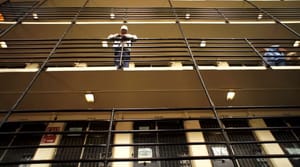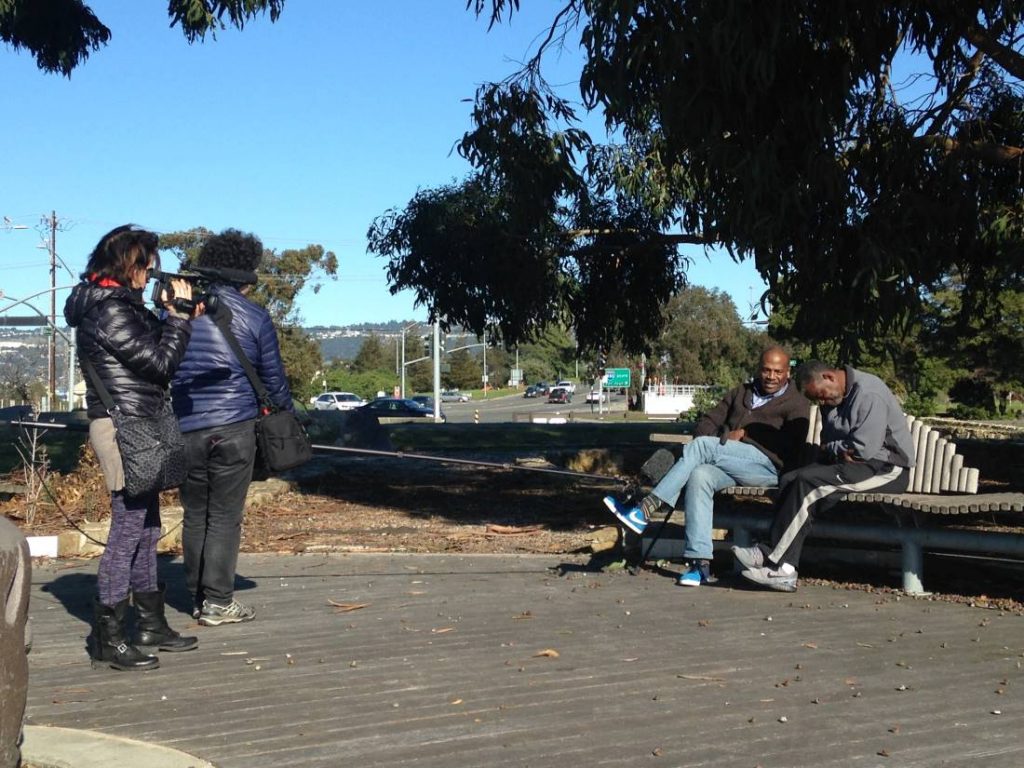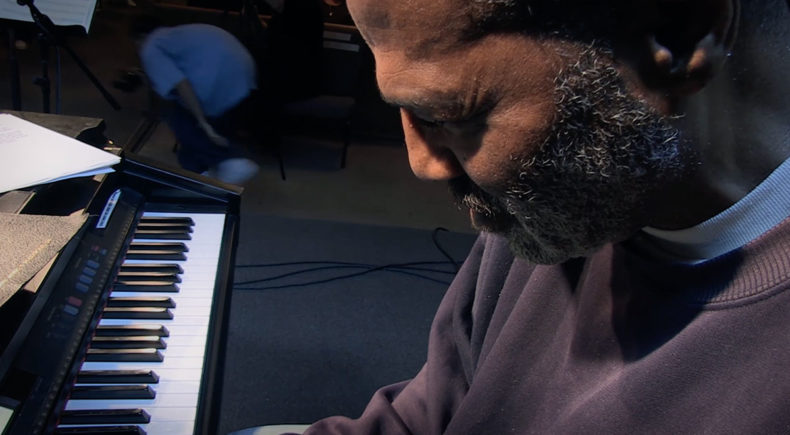
NC Heikin is a documentarian known for Kimjongilia and Sound of Redemption, The Frank Morgan Story. Her latest documentary, Life & Life, follows musician Reginald Austin, who is serving a life sentence in San Quentin state penitentiary. In the piece below, Heikin explains how she was able to film two feature documentaries inside the prison.
It’s an unusual thing to make a film about a guilty man. Many prison documentaries tilt toward stories of wrongful convictions overturned. But what about the guy who did it? In the abstract, I might not have been keen to make such a film, but as I got to know my subject, Reginald Austin, I realized he was much more than the crime he committed.
I met Austin while shooting a concert in San Quentin State Prison in 2012, for Sound of Redemption, The Frank Morgan Story, a film about the legendary jazz saxophonist. Morgan, who spent many years in prison due to heroin charges, led a renowned big band of fellow addicts inside San Quentin. I had decided to call up the spirit of those concerts by directing a new one.
We weren’t disappointed, and the event went way beyond our expectations. At one point during filming, Inmate #B57661, Reginald Austin, asked if he could sit in with the band.

Reggie was a tall, grizzled guy. He told us he had known Frank Morgan when “Frank was on his way out the door and I was starting a life sentence.” He sat down at the piano and played an impressive rendition of “Sugar” by Stanley Turrentine. I didn’t realize at the time that I would wind up following his story, but word got back to me that Reggie felt the night changed his life. He said it made him “feel like a human being again.” Those are powerful words.
We exchanged a couple of letters as he prepared for his 13th parole hearing two years later. When, amazingly, he was granted parole, I felt there might be a story. My first idea was to do a short on the power of music. As I dug deeper, the story became more complicated, especially dealing with his crime. But with each successive interview, he became more open, more heartfelt, and more compelling, and he made me curious to go back inside and meet the people he’d left behind.
Shooting Sound of Redemption in San Quentin — the beginning
Filming in a prison is complicated. There are many safety precautions and restrictions, some as simple as “Don’t wear blue!” The inmates are dressed in blue in California and you don’t want to be mistaken for an inmate if things go sideways. You cannot bring a cellphone inside, as they are valuable contraband. They must be checked at the gate. You can’t bring in a lot of cash. Keys need to be checked, and you go through a metal detector, so it’s best not to wear anything metal, including an underwire bra. Even something like an inhaler could be subject to scrutiny, so a doctor’s note is required. The atmosphere is very no-nonsense.
Constructing a lighting grid, hanging lights to look like a concert stage, bringing in top-drawer recording equipment and engineers, and wrangling five cameras all required a lot of coordination and approvals. And obviously, you don’t just walk in and shout, “Action!”
In order to enter the premises, we had to get permission from the California Department of Corrections and Rehabilitation. When we first started asking, there was a moratorium on live music in San Quentin because of a riot years prior. Eighteen months and many unanswered calls and emails later, we finally got the go-ahead. We hooked up with the affable Lt. Sam Robinson, San Quentin PR officer, who guided us through the practicalities.

We had to provide driver licenses or passports, addresses, and the date of birth of every person in the crew. Though we tried to keep our crew light, we still ended up with four people on lights, three on sound, three DPs, two producers, two PAs, one director (me), five musicians, and several musical instruments. On a manifest, we noted every scrap of equipment we were bringing in: ladders, cable cutters, saxophone reeds, music stands, wires, jacks, computers, mics, lights, clamps, et al. This level of detail was understandable — your mind starts imagining possibilities if a ladder were to go missing — but it definitely added tension. Plus, the concert was to be the most expensive day of filming I’d ever directed.
The evening before the big shoot, we had an information session with the assistant warden. Dress was important, including not just the color but also a directive to dress modestly — no skin showing, avoid jewelry, no short skirts. (One performer wound up wearing a very short skirt for the show — I didn’t realize how short it was on the hanger. Luckily, she was up on stage and we didn’t get any blowback.) And then there were instructions on what to do if you heard a particular bell or whistle: Freeze! Hit the ground! We have a “no hostage” policy! It was not reassuring.
Yet, for all the nail-biting in prep, the shoot was surprisingly low-key. Lt. Robinson took us through the premises to shoot B-roll. The inmates were unfailingly polite and helpful, the set-up went smoothly, and the concert itself was roof-raising.
Getting out is easier than getting in
Afterward, we could just pack up our gear, verify every item on the manifest, and walk out. We went in subconsciously expecting to meet fearful monsters at this maximum security death row prison, but we left with the overwhelming feeling that we had been among a bunch of guys who were as grateful as any audience for the joyous music.
Aside from meeting Reggie that night, I created important relationships with some of the people who work at the Q, especially Lt. Robinson. When I wanted to come back for Life & Life, this made everything infinitely easier. I knew what to expect, and they knew they could trust me.
We still had to go through the CDCR for permission, but, before COVID, the lead time was down to about three months. I’d still recommend starting six months ahead of time. Personnel can change, and bureaucracies slow down as a result. The process varies from state to state, but a good place to start would be with the state department of prisons. Remember that the folks you deal with are responsible for your safety, but, more importantly, for the smooth functioning of the institution. Prisons are crowded with potentially volatile personalities, so it’s important to respect the guidelines they lay down. No matter what you think of the criminal justice system, it’s not a good place to come off as arrogant… especially if you ever want to be able to go back in.
Unlocking Reggie Austin
The Sound of Redemption San Quentin concert was in 2012. Reggie’s 13th parole hearing was in 2014. His release was in 2015. I sent director of photography Don Starnes to San Quentin to cover it. When Reggie was invited to play at the Frank Morgan Taos Jazz Festival, I could see a through-line of the serendipitous musical meeting in San Quentin to his liberation and eventually his musical triumph in New Mexico. Eventually things happened that changed the through-line dramatically, but I stuck with my plan to go back inside and meet the guys Reggie left behind, who were all musicians. I had a great relationship with Lt. Robinson by then, so my request to come back in was approved relatively quickly, and the music program officials were accommodating.
Also read: Geena Davis Has the Perfect Answer to Whether Thelma & Louise Should Have Been Directed by a Woman
Don’t give up
This could be any filmmaker’s motto. The idea is especially apropos to Reggie’s story, since it took him 35 years and 13 parole hearings to get out of prison. A few years on a film seems relatively easy in comparison. Dealing with big bureaucracies, like a state prison department, takes patience. But the rewards are great. The people inside need to be heard.
And do pay attention to dress codes. On our last shoot, DP Mike Seely didn’t think the “no blue” rule applied to his blue jeans — until we were denied entry. We sent a PA scurrying to find a pair of black jeans for him to wear. They looked good. I wonder if he still has them.
Life & Life, directed by NC Heikin, screens today at the Martha’s Vineyard African American Film Festival, a festival which runs through Saturday.
